|
Deep
beneath the ground in Geneva, scientists and engineers are building
the world's most complicated machine. The Large Hadron Collider
promises to reveal the secrets of the Big Bang…
by Alom Shaha
Thousands of scientists from around the world are betting their bottom dollar, scientifically speaking, on a giant machine now being constructed beneath the borders of Switzerland and France. This is the home of the European Organization for Nuclear Physics, commonly known by its French initials CERN.
The new device is called the Large Hadron Collider, and it will run the biggest scientific experiment of all time. The machine will smash together atoms and other particles at the highest speeds ever achieved on Earth, recreating the conditions of the Big Bang. The Large Hadron Collider will open new frontiers of physics, and promises to unlock some of the secrets of the birth of the Universe.
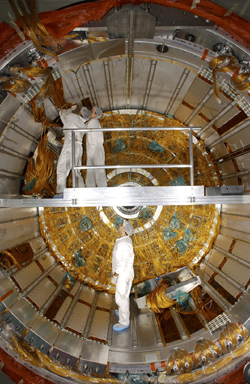
CERN
A giant
detector to seek out the smallest particles
|
Recently, I was privileged to be taken behind the scenes at CERN, and get a glimpse into the incredible engineering and construction work that will make the experiment possible. The sheer scale of the Large Hadron Collider is overwhelming: an underground machine the size of a vast building is being built to detect particles far too small to be seen!
I came away inspired, rather wishing that I had stayed on in physics after my degree so that I could now be working on this amazing project. My guides were two leading young British physicists, Jon Butterworth from University College London and Brian Cox of Manchester University, who are helping with the UK's contribution to the Large Hadron Collider.
The Large Hadron Collider will produce beams of subatomic particles, and accelerate them to speeds close to the speed of light. These particles, known as "hadrons", are relatively heavy on the atomic scale of things, and include protons and the nuclei of atoms.
The particles are injected into a ring-shaped evacuated tube that runs around inside a 27-kilometre long circular tunnel. They will whiz around several times before colliding - with energies that match the raw power of the Big Bang. The collisions will produce new particles that have never existed on Earth, and may not exist anywhere else in the Universe. The scientists at CERN - the "lords of the ring" - expect that the properties of these new particles will help them understand why the Universe is the way that it is, and to answer one of the biggest remaining questions in physics: why do things have mass?
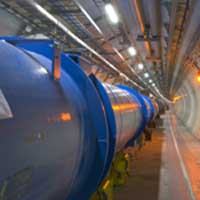
CERN
Inside the 27-kilometre
long tube, particles rush to their doom
|
The Large Hadron Collider is the most complicated object ever
built by humans. Working at 300 degrees below room temperature and
using the most powerful lasers, magnets and computers available,
the scientists operating the Large Hadron Collider will probe deeper
into matter than ever before.
Five experiments, with huge detectors, will study what happens when the Large Hadron Collider's beams of subatomic particles smash into each other. The detectors will handle as much information as the entire European telecommunications network, in the hope of coming up with a result that's worth the billions of euros that the project is costing.
ATLAS, the detector
that Jon Butterworth and Brian Cox are helping to build, will weigh
7000 tonnes. Once in operation, it will be immersed in dangerous
levels of radiation, and must be and be kept at a temperature close
to absolute zero by the most sophisticated cooling system on the
planet. The various parts of the machine will need to be aligned
to an accuracy of 10 millionths of a metre and it will collect data
at a rate equivalent to ten thousand Encyclopaedia Brittanicas per
second.
"There's a hell
of a lot of complex physics and engineering," Brian explains. "A
lot of people see these things and think you go to a company and
say 'build us a detector'. But you don't; because this is a one-off.
There are some things in common with other industries, but no one
needs exactly all the properties that we've got. So there's a lot
of physics you have to do to make sure it works; and a lot of engineering
you have to do put the thing together."
Even for the simplest tasks, Brian engages PhD students and graduates with first class honours degrees. "Quite a lot of the time they're gluing stuff together, sticking wires on things and seeing if they work. And that's kind of the grubby bit of particle physics that you've got to do in order to achieve all this wonderful stuff".
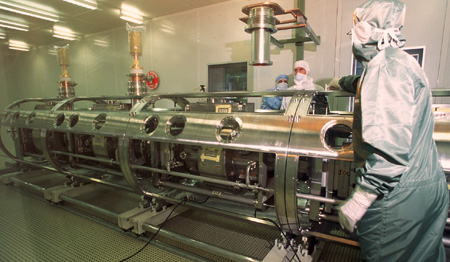
CERN
The precision components are assembled in superclean
conditions
|
Jon's team at UCL is working on part of the tracking, "basically the cameras which surround these collisions - the same technology that's in the centre of a digital camera. Except it's about this big…"
He holds his arms apart as far as they'll go. "And it's super aligned, because at tens of microns resolution, you need to really know where it is. We've been building it in the UK, and not just at UCL: in fact it was assembled in a basement at Oxford. It's a bit James Bond down there, there are guys in snowsuits and clean rooms - it's very, very precise stuff.
"When they send it over here," Jon continues, "all the bits have got to slot into each other. And then it slots into an even bigger detector that's been built by someone else in Germany. And then that slots into an even bigger one. There are bits being built in Manchester, bits being built in Liverpool, quite a lot being built in Geneva and the US as well. It's kind of an onion affair - and we're at about layer two of the onion."
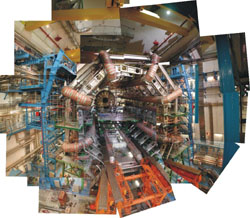
Maurice Goodrick
Photo-montage captures
the complexity of the ATLAS detector
|
Over seven thousand scientists are working at CERN: the "fellowship of the ring" is made up of representatives from 80 countries. This international collaboration goes back over 50 years, to the foundation of CERN.
At a time when the world seems divided and full of conflict, I found it inspiring to be in a place where scientists from all political, religious and cultural backgrounds have come together to make this machine work. But what motivates them? According to Jon, it's the sheer lust for data: "Everyone wants to know everything. It's not like one person wants to know one thing about a collision and another wants to know another. Everyone wants to know the whole story."
As well as ensuring that all the pieces of equipment fit together like one big complicated jigsaw puzzle, the philosophy of cooperation extends to the results from the giant machine. "All the data goes to the same place and then everyone who built a little bit of the detector gets all the data from all of it," Jon explains. "And we all share the analysis as well. So it's a real genuine collaboration. It's actually our facility and we all use it. It forces us to talk to each other more than you would normally in a big international lab where you come, do your science and go away again."
Jon and Brian met some 10 years ago, when they were working on rival experiments on a particle accelerator in Hamburg. According to Jon, "Hamburg is a nice place to go to, lots of nice bars so it's a good social life for the physicists out there". I discovered that socialising was also a key element in the approach to physics at CERN, and spent a lot of time eating and drinking with the physicists as they expounded the new science that they hope to crack.
As well as a five-course feast at Le Coq Rouge just across the border in France, and the best steak and chips I've ever had, I had the privilege of dining in the legendary CERN café. It was one of the first buildings to be built on the site. According to Jon, "a lot of the big decisions in particle physics about what to do next, how to find out the things that you don't know were made here."
Although these decisions have enormous implications for how millions of euros of funding are spent and the future of particle physics, Jon echoes a lot of the other scientists I met in saying: "it's better to make them over a coffee or a beer than it is to make them in a boardroom".
Hub of the Universe:
Brian Cox (left) and Jon Butterworth outside the CERN
cafe
|
An earlier generation of accelerators has already answered many questions about the nature of matter, giving us a much greater understanding of the Universe. Along the way, the answers have changed our daily lives, giving us televisions, transistors, medical imaging and a host of other new technologies. Most famously, the World Wide Web was invented at CERN. However, many people still question science of this scale and ask whether it's really worth all the time, effort and money.
This is a question
that Jon has clearly had to deal with before: "This is frontier
research, there's no new drug going to come from this directly,
and certainly not a new bomb", he told me, referring to the suggestion
made in Dan Brown's blockbuster Angels & Demons, which
is set partly at CERN.
"You get attacked so often. I think it's important to make clear that we're not doing this for the spin offs or the benefits, we're doing it for the curiosity. It's curiosity-driven science, and to my mind that's one of the defining qualities of civilization. There's a certain limit to the expenditure that the public will put up - and this is what you get for it."
According to Brian, it's the only thing we can do if we want to find out how the Universe works: "If you could, what you'd like to do is to go back to the Big Bang, and see what's happening. But we can't do that because you can't travel back in time. So you recreate the conditions as closely as you can. We're creating a little bit of the Big Bang, sticking it in a high precision detector and having a look as closely as we can - to see what happens".
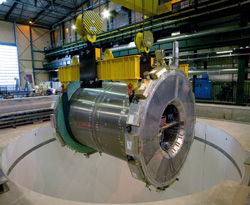
CERN
Work in progress: part of the Atlas detector
is lowered 90 metres into the ground
|
With so many delicate components that need to come together, and so much potential for error, the science community is waiting with bated breath for the Large Hadron Collider to be completed. Once switched on, the race will be on to analyse the data and find the answers they've all been waiting for. Hopefully, sometime in 2007, there'll be an announcement that will change the way we think about the Universe forever.
|
